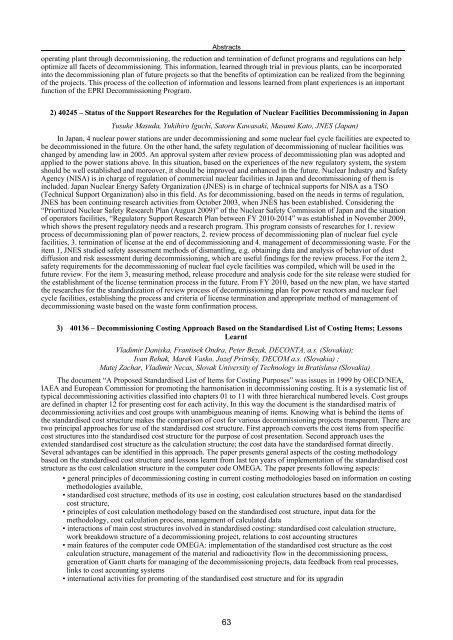The 13th International Conference on Environmental ... - Events
The 13th International Conference on Environmental ... - Events
The 13th International Conference on Environmental ... - Events
Create successful ePaper yourself
Turn your PDF publications into a flip-book with our unique Google optimized e-Paper software.
Abstracts<br />
operating plant through decommissi<strong>on</strong>ing, the reducti<strong>on</strong> and terminati<strong>on</strong> of defunct programs and regulati<strong>on</strong>s can help<br />
optimize all facets of decommissi<strong>on</strong>ing. This informati<strong>on</strong>, learned through trial in previous plants, can be incorporated<br />
into the decommissi<strong>on</strong>ing plan of future projects so that the benefits of optimizati<strong>on</strong> can be realized from the beginning<br />
of the projects. This process of the collecti<strong>on</strong> of informati<strong>on</strong> and less<strong>on</strong>s learned from plant experiences is an important<br />
functi<strong>on</strong> of the EPRI Decommissi<strong>on</strong>ing Program.<br />
2) 40245 – Status of the Support Researches for the Regulati<strong>on</strong> of Nuclear Facilities Decommissi<strong>on</strong>ing in Japan<br />
Yusuke Masuda, Yukihiro Iguchi, Satoru Kawasaki, Masami Kato, JNES (Japan)<br />
In Japan, 4 nuclear power stati<strong>on</strong>s are under decommissi<strong>on</strong>ing and some nuclear fuel cycle facilities are expected to<br />
be decommissi<strong>on</strong>ed in the future. On the other hand, the safety regulati<strong>on</strong> of decommissi<strong>on</strong>ing of nuclear facilities was<br />
changed by amending law in 2005. An approval system after review process of decommissi<strong>on</strong>ing plan was adopted and<br />
applied to the power stati<strong>on</strong>s above. In this situati<strong>on</strong>, based <strong>on</strong> the experiences of the new regulatory system, the system<br />
should be well established and moreover, it should be improved and enhanced in the future. Nuclear Industry and Safety<br />
Agency (NISA) is in charge of regulati<strong>on</strong> of commercial nuclear facilities in Japan and decommissi<strong>on</strong>ing of them is<br />
included. Japan Nuclear Energy Safety Organizati<strong>on</strong> (JNES) is in charge of technical supports for NISA as a TSO<br />
(Technical Support Organizati<strong>on</strong>) also in this field. As for decommissi<strong>on</strong>ing, based <strong>on</strong> the needs in terms of regulati<strong>on</strong>,<br />
JNES has been c<strong>on</strong>tinuing research activities from October 2003, when JNES has been established. C<strong>on</strong>sidering the<br />
“Prioritized Nuclear Safety Research Plan (August 2009)” of the Nuclear Safety Commissi<strong>on</strong> of Japan and the situati<strong>on</strong><br />
of operators facilities, “Regulatory Support Research Plan between FY 2010-2014” was established in November 2009,<br />
which shows the present regulatory needs and a research program. This program c<strong>on</strong>sists of researches for 1. review<br />
process of decommissi<strong>on</strong>ing plan of power reactors, 2. review process of decommissi<strong>on</strong>ing plan of nuclear fuel cycle<br />
facilities, 3. terminati<strong>on</strong> of license at the end of decommissi<strong>on</strong>ing and 4. management of decommissi<strong>on</strong>ing waste. For the<br />
item 1, JNES studied safety assessment methods of dismantling, e.g. obtaining data and analysis of behavior of dust<br />
diffusi<strong>on</strong> and risk assessment during decommissi<strong>on</strong>ing, which are useful findings for the review process. For the item 2,<br />
safety requirements for the decommissi<strong>on</strong>ing of nuclear fuel cycle facilities was compiled, which will be used in the<br />
future review. For the item 3, measuring method, release procedure and analysis code for the site release were studied for<br />
the establishment of the license terminati<strong>on</strong> process in the future. From FY 2010, based <strong>on</strong> the new plan, we have started<br />
the researches for the standardizati<strong>on</strong> of review process of decommissi<strong>on</strong>ing plan for power reactors and nuclear fuel<br />
cycle facilities, establishing the process and criteria of license terminati<strong>on</strong> and appropriate method of management of<br />
decommissi<strong>on</strong>ing waste based <strong>on</strong> the waste form c<strong>on</strong>firmati<strong>on</strong> process.<br />
3) 40136 – Decommissi<strong>on</strong>ing Costing Approach Based <strong>on</strong> the Standardised List of Costing Items; Less<strong>on</strong>s<br />
Learnt<br />
Vladimir Daniska, Frantisek Ondra, Peter Bezak, DECONTA, a.s. (Slovakia);<br />
Ivan Rehak, Marek Vasko, Jozef Pritrsky, DECOM a.s. (Slovakia) ;<br />
Matej Zachar, Vladimir Necas, Slovak University of Technology in Bratislava (Slovakia)<br />
<str<strong>on</strong>g>The</str<strong>on</strong>g> document “A Proposed Standardised List of Items for Costing Purposes” was issues in 1999 by OECD/NEA,<br />
IAEA and European Commissi<strong>on</strong> for promoting the harm<strong>on</strong>isati<strong>on</strong> in decommissi<strong>on</strong>ing costing. It is a systematic list of<br />
typical decommissi<strong>on</strong>ing activities classified into chapters 01 to 11 with three hierarchical numbered levels. Cost groups<br />
are defined in chapter 12 for presenting cost for each activity. In this way the document is the standardised matrix of<br />
decommissi<strong>on</strong>ing activities and cost groups with unambiguous meaning of items. Knowing what is behind the items of<br />
the standardised cost structure makes the comparis<strong>on</strong> of cost for various decommissi<strong>on</strong>ing projects transparent. <str<strong>on</strong>g>The</str<strong>on</strong>g>re are<br />
two principal approaches for use of the standardised cost structure. First approach c<strong>on</strong>verts the cost items from specific<br />
cost structures into the standardised cost structure for the purpose of cost presentati<strong>on</strong>. Sec<strong>on</strong>d approach uses the<br />
extended standardised cost structure as the calculati<strong>on</strong> structure; the cost data have the standardised format directly.<br />
Several advantages can be identified in this approach. <str<strong>on</strong>g>The</str<strong>on</strong>g> paper presents general aspects of the costing methodology<br />
based <strong>on</strong> the standardised cost structure and less<strong>on</strong>s learnt from last ten years of implementati<strong>on</strong> of the standardised cost<br />
structure as the cost calculati<strong>on</strong> structure in the computer code OMEGA. <str<strong>on</strong>g>The</str<strong>on</strong>g> paper presents following aspects:<br />
• general principles of decommissi<strong>on</strong>ing costing in current costing methodologies based <strong>on</strong> informati<strong>on</strong> <strong>on</strong> costing<br />
methodologies available,<br />
• standardised cost structure, methods of its use in costing, cost calculati<strong>on</strong> structures based <strong>on</strong> the standardised<br />
cost structure,<br />
• principles of cost calculati<strong>on</strong> methodology based <strong>on</strong> the standardised cost structure, input data for the<br />
methodology, cost calculati<strong>on</strong> process, management of calculated data<br />
• interacti<strong>on</strong>s of main cost structures involved in standardised costing: standardised cost calculati<strong>on</strong> structure,<br />
work breakdown structure of a decommissi<strong>on</strong>ing project, relati<strong>on</strong>s to cost accounting structures<br />
• main features of the computer code OMEGA: implementati<strong>on</strong> of the standardised cost structure as the cost<br />
calculati<strong>on</strong> structure, management of the material and radioactivity flow in the decommissi<strong>on</strong>ing process,<br />
generati<strong>on</strong> of Gantt charts for managing of the decommissi<strong>on</strong>ing projects, data feedback from real processes,<br />
links to cost accounting systems<br />
• internati<strong>on</strong>al activities for promoting of the standardised cost structure and for its upgradin<br />
63
















